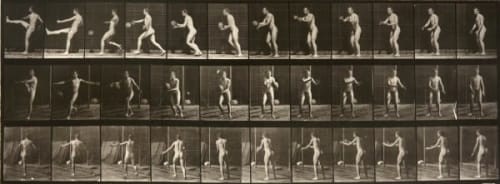Eadweard Muybridge
Eadweard Muybridge, born Edward James Muggeridge on April 9, 1830, in Kingston upon Thames, England, was a pioneering photographer and a key figure in the development of motion pictures. Muybridge’s work revolutionized the way we perceive and understand motion, marking a significant advancement in the field of visual representation.
In the 1850s, Muybridge immigrated to the United States, where he initially worked as a bookseller and later as a successful landscape photographer. His interest in capturing motion was sparked when Leland Stanford, a wealthy businessman and racehorse owner, approached him with a question: Do all four hooves of a galloping horse leave the ground at the same time? In pursuit of answering Stanford’s question, Muybridge embarked on a groundbreaking photographic experiment. He developed a series of innovative techniques and devices, including the use of multiple cameras triggered by tripwires, to capture a sequence of images that depicted the fluid movement of a galloping horse. In 1878, after numerous attempts and refinements, Muybridge successfully captured the sequence, conclusively proving that a horse’s hooves do leave the ground simultaneously during a gallop. Muybridge’s motion studies had a profound impact on the worlds of art, science, and entertainment. His photographic sequences revealed the hidden intricacies of movement, allowing artists and scientists to understand and depict motion more accurately. His work also laid the foundation for the development of motion pictures, influencing the likes of Thomas Edison and the Lumière brothers in their quest to create moving images.
Beyond his motion studies, Muybridge’s photography encompassed a wide range of subjects, including landscapes, architecture, and portraits. He traveled extensively, capturing the vast and diverse landscapes of the American West and Central America. In addition to his artistic contributions, he was a technological innovator. He patented several inventions, including improvements to the zoopraxiscope, a device that projected his photographic sequences and predated modern film projectors. Despite his significant achievements, his life was not without controversy. In 1874, he was charged with murdering his wife’s lover, but was acquitted on the grounds of “justifiable homicide.” Eadweard Muybridge’s legacy endures to this day, as his contributions to the fields of photography and motion study continue to be celebrated and explored.




